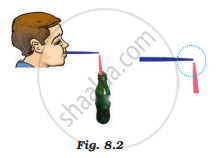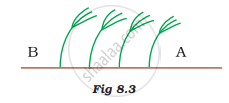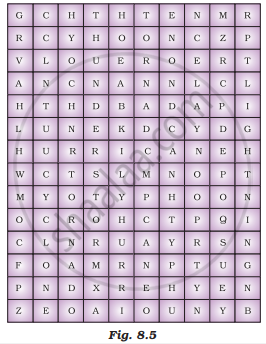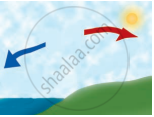Advertisements
Online Mock Tests
Chapters
2: Nutrition in Animals
3: Fibre to Fabric
4: Heat
5: Acids, Bases and Salts
6: Physical and Chemical Changes
7: Weather, Climate and Adaptation of Animals to Climate
▶ 8: Wind, Storm and Cyclone
9: Soil
10: Respiration in Organisms
11: Transportation in Animals and Plants
12: Reproduction in Plants
13: Motion and Time
14: Electric Current and Its Effects
15: Light
16: Water : A Precious Resource
17: Forests : Our Lifeline
18: Wastewater Story
![NCERT Exemplar solutions for Science [English] Class 7 chapter 8 - Wind, Storm and Cyclone NCERT Exemplar solutions for Science [English] Class 7 chapter 8 - Wind, Storm and Cyclone - Shaalaa.com](/images/science-english-class-7_6:5f2b1b2038084cf381bfa42c826a928c.jpg)
Advertisements
Solutions for Chapter 8: Wind, Storm and Cyclone
Below listed, you can find solutions for Chapter 8 of CBSE NCERT Exemplar for Science [English] Class 7.
NCERT Exemplar solutions for Science [English] Class 7 8 Wind, Storm and Cyclone MULTIPLE CHOICE QUESTIONS [Pages 42 - 44]
A fire alarm usually detects smoke in case of fire. Where should such an alarm be placed in a room?
Near the door
On the floor
On any wall
On the ceiling
Four schematic diagrams are shown in the Figure to depict the direction of the sea breeze. Which of them gives the correct direction?
Figure 8.2 shows a child blowing air with a straw near the opening of another straw which has its other end in a soft drink bottle. It was observed that the level of the soft drink in the straw rises up as soon as air is blown over its open end. Which one of the following best explains the reason for rising in the level of the drink?

The blowing of air decreases pressure over the opening of the straw.
The straw of the soft drink bottle collapses when air is blown over its open end.
The blowing of air warms up the air inside the straw
The blowing of air increases the pressure on the surface of the soft drink in the bottle.
Following are precautions one must take in case a storm is accompanied by lightning.
(i) Do not take shelter under a tree.
(ii) Do not take shelter under an umbrella with a metallic end.
(iii) Do not take shelter in open garages, storage sheds, etc.
(iv) Do not take shelter in a bus in the open.
Which one of these is not correct?
(i)
(ii)
(iii)
(iv)
Which of the following place is most likely to be affected by a cyclone?
Mumbai
Puri
Goa
Porbandar
A curtain is hanging at the entrance of a room. A long corridor runs at right angles to the door, that is parallel to the curtain. If a strong wind blows along the corridor, the curtain will
get pushed inside the room.
get pushed outside the room.
get collected towards one end/swirled.
remain unaffected.
NCERT Exemplar solutions for Science [English] Class 7 8 Wind, Storm and Cyclone VERY SHORT ANSWER QUESTIONS [Pages 44 - 45]
Why is Chandigarh unlikely to be affected by a cyclone?
Name the ocean which is mainly responsible to bring rain-bearing monsoon winds to the Kerala coast in June every year?
Fill in the blanks.
Air around us exerts __________ .
The moving air is called _________ .
The main cause of wind movement is uneven ___________ on the earth.
High speed wind can cause cyclone in regions of ___________ pressure.
State whether the following statement is True or False:
If wind flows from land to the ocean, then it is daytime
True
False
State whether the following statement is True or False:
A very high-pressure system, with very high speed wind surrounding it, forms a cyclone.
True
False
State whether the following statement is True or False:
The coastline of India is not vulnerable to cyclones
True
False
State whether the following statement is True or False:
Warm air is lighter than cool air.
True
False
To expel hot air out of the kitchen, ‘A’ has an exhaust fan fitted on the window of her kitchen and ‘B’ has a similar exhaust fan fitted on the wall near the ceiling of her kitchen. Which of the exhaust fan will expel the hot air more effectively? Explain why?
Why is it advisable not to shut all the doors and windows during a storm?
A flat in Mumbai with a balcony facing the sea has some clothes hung on a clothesline in the balcony. Towards which direction the clothes will be blown in the afternoon? Explain.
Figure 8.3 shows a diagrammatic representation of trees in the afternoon along a sea coast. State on which side is the sea; A or B? Give reasons for your choice.

A flag mounted on a flag post near the sea coast flutters in the direction of the sea. At what time of the day does this happen – at midnight or in the afternoon?
NCERT Exemplar solutions for Science [English] Class 7 8 Wind, Storm and Cyclone SHORT ANSWER QUESTIONS [Page 45]
Match Column I with Column II. There can be more than one match.
| Column I | Column II | ||
| (a) | on heating air | (i) | descends |
| (b) | on cooling air | (ii) | expands |
| (iii) | contracts | ||
| (iv) | rises | ||
Paheli kept an empty bottle made of plastic inside a refrigerator. After a few hours, when she opened the refrigerator she found the bottle had collapsed. Explain the possible reason.
When strong/high-speed wind blows, an umbrella held upright at times gets upturned. Explain the reason.
Suggest some precautions to be taken to prevent the roof of a tin sheet from flying away during a fierce wind storm.
NCERT Exemplar solutions for Science [English] Class 7 8 Wind, Storm and Cyclone LONG ANSWER QUESTIONS [Page 46]
Describe an activity to demonstrate that warm air is lighter than cool air
The picture in Figure 8.4 shows a tree line along the sea coast on an island near the equator. As shown, the treetops are permanently bent in one direction. Are the trees bent towards the sea or away from it? Explain.

Identify the names of six natural phenomena from the following word diagram given in Figure 8.5.

Solutions for 8: Wind, Storm and Cyclone
![NCERT Exemplar solutions for Science [English] Class 7 chapter 8 - Wind, Storm and Cyclone NCERT Exemplar solutions for Science [English] Class 7 chapter 8 - Wind, Storm and Cyclone - Shaalaa.com](/images/science-english-class-7_6:5f2b1b2038084cf381bfa42c826a928c.jpg)
NCERT Exemplar solutions for Science [English] Class 7 chapter 8 - Wind, Storm and Cyclone
Shaalaa.com has the CBSE Mathematics Science [English] Class 7 CBSE solutions in a manner that help students grasp basic concepts better and faster. The detailed, step-by-step solutions will help you understand the concepts better and clarify any confusion. NCERT Exemplar solutions for Mathematics Science [English] Class 7 CBSE 8 (Wind, Storm and Cyclone) include all questions with answers and detailed explanations. This will clear students' doubts about questions and improve their application skills while preparing for board exams.
Further, we at Shaalaa.com provide such solutions so students can prepare for written exams. NCERT Exemplar textbook solutions can be a core help for self-study and provide excellent self-help guidance for students.
Concepts covered in Science [English] Class 7 chapter 8 Wind, Storm and Cyclone are Wind: The Movement of Air, Atmospheric Pressure, High Speed Winds Are Accompanied by Reduced Air Pressure, Air Expands on Heating, Wind Currents Are Generated Due to Uneven Heating on the Earth, Thunderstorms, Cyclones, Thunderstorm and Cyclone: Destruction Causes, Safety Measures and Role of Advanced Technology.
Using NCERT Exemplar Science [English] Class 7 solutions Wind, Storm and Cyclone exercise by students is an easy way to prepare for the exams, as they involve solutions arranged chapter-wise and also page-wise. The questions involved in NCERT Exemplar Solutions are essential questions that can be asked in the final exam. Maximum CBSE Science [English] Class 7 students prefer NCERT Exemplar Textbook Solutions to score more in exams.
Get the free view of Chapter 8, Wind, Storm and Cyclone Science [English] Class 7 additional questions for Mathematics Science [English] Class 7 CBSE, and you can use Shaalaa.com to keep it handy for your exam preparation.




